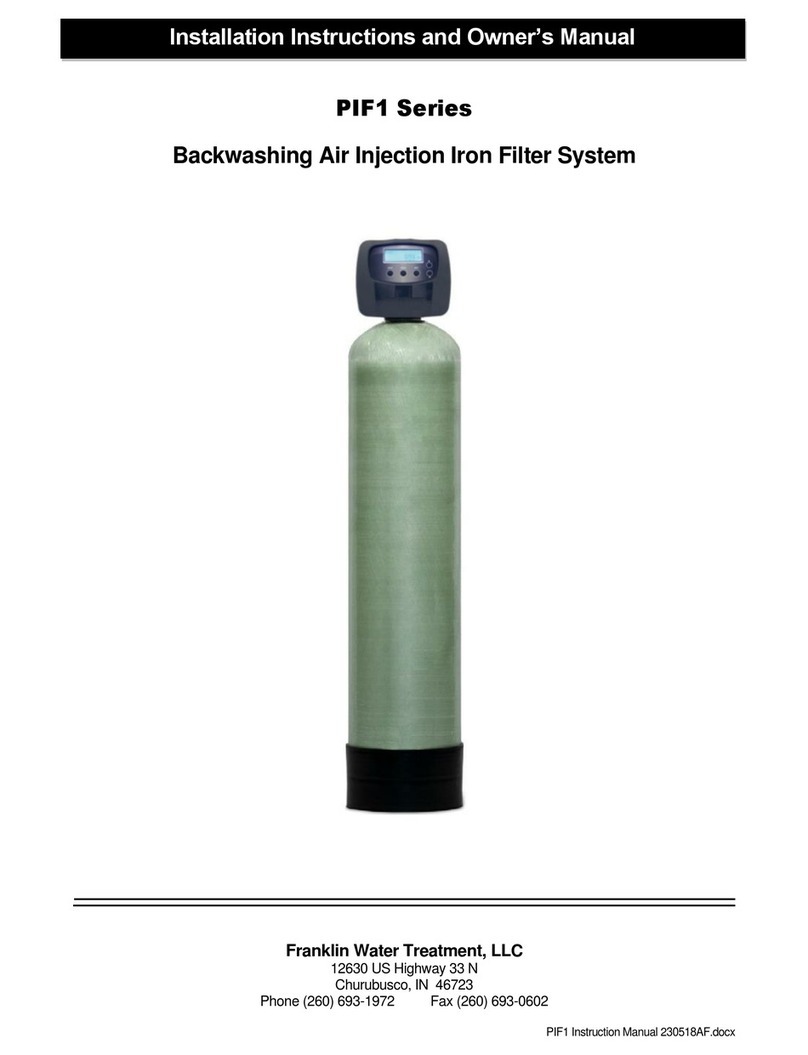6
STEP 1: Unpack filter unit, making sure to remove entire contents of the shipping container prior to disposal.
STEP 2: Withthefilterunitintheuprightposition,removethecontrolvalvefromthemineraltankbeingcareful
to not pull the distributor out of the gravel at the bottom of the tank. If the filter model has a “-DH”
suffix, do not remove the control valve. Just remove the tank dome hole plug.
STEP 3: Ifthecontrol valve wasremoved,coverthe top of the distributortubewiththeincludedredcap.Using
the included blue media funnel, pour filter media(s) into the mineral tank. If using multiple filter
media types, load in the order of heaviest (most dense) to lightest (least dense). 14” of space MUST
be left empty at the top of themineral tank to allow for media bed expansion during backwash and to
prevent filter media from being discharged through the drain line.
STEP 4: Use a garden hose or bucket to fill the media tank with water.
IMPORTANT: Carbon, Filter Ag, Zeolite and Greensand Plus must be soaked for at least 2
hours prior to submitting it to full backwash flow rate to prevent loss of media to drain.
STEP 5: Clean mineral tank threads to remove any filter media. If the control valve was removed, remove red
cap from distributor tube and reinstall control valve by threading it securely onto the mineral tank.
Otherwise simply replace the tank dome hole plug. (O-ring seal: HAND TIGHTEN ONLY!)
STEP 6: Shutoff allwateratmainsupply. Onprivatewellsystem,turnoffpowertopumpanddrainpressure
tank. Make certain pressure is relieved from complete system by opening nearest faucet to drain
system. SHUT OFF FUEL / ELECTRICAL SUPPLY TO WATER HEATER.
STEP 7: Plumb the water supply line to the unit's bypass valve inlet, located at the right rearas you face the
unit. There are a variety of installation fittings available. They are listed under Installation Fitting
Assemblies, pages 23-25.Whenassembling theinstallation fittingpackage(inletand outlet), connect
the fitting to the plumbing system first and then attach the nut, split ring, and "O" Ring. Heat from
soldering orsolventcements may damage thenut, split ring,or "O" Ring. Solderjoints shouldbecool
and solvent cements should be set before installing the nut, split ring, and "O" Ring. Avoid getting
solder flux, primer, and solvent cement on any part of the "O" Rings, split rings, bypass valve, or
controlvalve.Ifthebuilding'selectricalsystemisgroundedto theplumbing,installacoppergrounding
strap from the inlet to the outlet pipe. Plumbing must be done in accordance with all applicable local
codes. MAKE CERTAIN WATER ENTERS THROUGH INLET AND DISCHARGES THROUGH
OUTLET.
STEP 8: Apply thread tape to DLFC Assembly. Remove drain line flow control (DLFC) retainer clip (Figure
6, Page 7) and remove the DLFC assembly from the valve body, (Figure 6, Page 7). Apply thread
tapetothreads.Slidedrainfittingcompressionnutontoprovideddraintubingandplacethetubeinsert
insidetheend ofthetubing. Inserttubingendwithinsertintodrain elbowandtightenthecompression
nut onto the thread taped elbow. Reinsert DLFC assembly into the valve body, making certain it is
FULLY inserted before replacing the retaining clip.
STEP 9: Install drain line. Use the provided ½” I.D. polyethylene tubing (DO NOT USE FLEXIBLE VINYL
TUBING!) to run drain line from controlvalve DLFC fitting(Figure6,Page 7) to floordrain or sumppit
capable of handling the backwash rate of the filter (refer to specifications and flow rate on page 17)
or discard the compression fitting and use the ¾” NPT fitting to connect a rigid pipe drain line . If
backwash flow rate is greater than 7.5 gpm, use existing NPT connector with rigid drain line. There
must be an air gap at the end of the drain line to prevent siphoning of wastewater. Length of drain
line should be 15’ or less. AVOID OVERHEAD DRAINS.





































